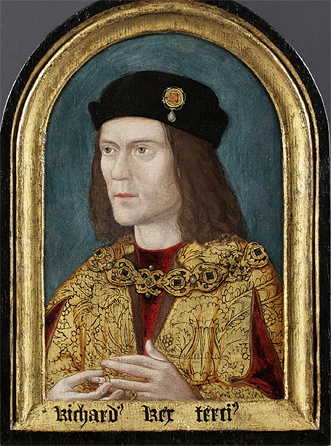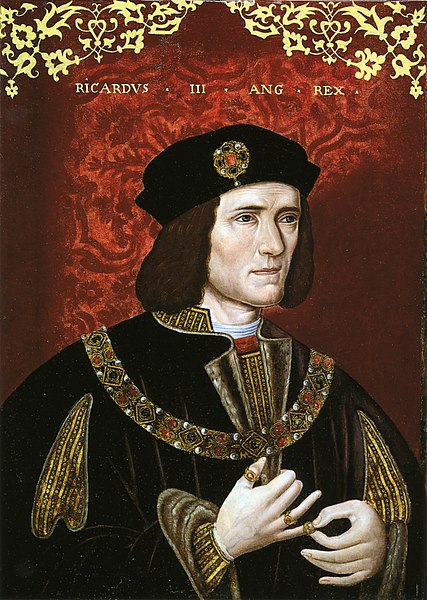 |
| Wikipedia Commons |
In a portrait about 200 years after his death:
 |
| Wikipedia Commons |
And in the very, very late death mask we have attempted to reconstruct using modern technology:
 |
| Channel 4/BBC.co.uk |
He looks so young. Richard III was only 32 when he died - and the body we know now to have been his had been scarred severely by a lifetime at war. By scoliosis, too, yes. But the eyes of all these portraits speak to the depth and weight of responsibility; of not only his own reign - and its loss - but of his brother's, Edward IV - and even of that of Henry VI, whose weakness made for such an interesting period in the Wars of the Roses. He looks so young to me.
5 comments:
And he looks rather handsome, too. This has been such a fascinating story, and I'm glad they did the facial reconstruction. Very fascinating, indeed.
I have to admit, I absolutely would have dated that guy. When I was younger. Erm. I'm 13 years older than he was - when he died. But of course he's got over 500 years on us. And of course there is the deadness.
I will shut up now. But yes. A very good looking Plantagenet, indeed.
Oh yes, I would have dated him too!
So how accurate might the first portrait be? Did the artist have access to people who saw RIII? I can conceive how the hat and that cute ornament (excuse my vast ignorance) might have survived him and contributed to at least sartorial accuracy.
"Scientific" facial reconstructions have been inescapable for decades, dating back to the days when documentary producers balked at using re-enactments and Hollywood footage, and enlisted physical anthropologists to provide a louphole through which some image could be projected. But more often, they reflect the makers as much as the subject.
There are those saying the later portraits' similarity to one another justifies the assumption that they must therefore resemble the model, but that's as flawed as forensic reconstruction. I think the science of creating models like this one is fascinating, and can tell us some useful information - BUT, as Elizabeth Chadwick put it, the reconstruction looks like a session from Glamour Shots with some cosmetic smoothing we can't verify. He could have had spots or a lazy eye we're not seeing, he could have lacked the KEY Ricardian romantic ingredient - the pathos seen in all these images. The very emotional responses people are having to the new image is telling, as is my own above.
Finding Richard like this is ROMANTIC, above all - for some, in the actual amorous sense, clearly - for some, in the sense of the story at play - for some, at the idea of centuries' injustice righted. The woman central to all this has stated that Richard's corporeal loss was one of the greatest injustices in history.
That's a pretty hefty dose of poor perspective, even if I do tend to skew more Ricardian than Henrician in my beliefs, at least about the Princes in the Tower ...
I think people are having FUN with this, above all. It's invigorating and entertaining for us history nerds, especially watching others peek into history and geek a little with us. It is in its way harmless diversion, and the intriguing questions - and answers - must have set untold throngs of people's creative juices into action. We like the idea of seeing the un-see-able, and being told it might be visible after all.
We must grasp the ineffable and see if we might not eff it after all, or something wittier as the Douglas Adams quote unquestionably actually was. But I can't see it right now, and am too lazy to search it ...
Post a Comment